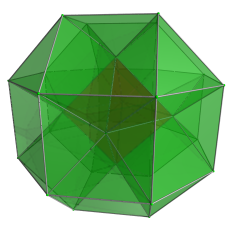User:Padex/hypercupola
Appearance
Hypercupola
[edit]I've found that, in 3 dimensions, cupolas are formed by an "expansion" of pyramids.
So, in 4D, I've found 4 hypercupolas:
| Hypercupolas | ||||||||
|---|---|---|---|---|---|---|---|---|

|

|

|
||||||
| Type | ||||||||
| Vertices | ||||||||
| Edges | ||||||||
| Faces | 18 squares |
48 squares |
42 squares |
90 squares 24 pentagons | ||||
| Cells | 4 triangular prisms 6 triangular prisms 4 tetrahedra 1 cuboctahedron |
6 cubes 12 triangular prisms 8 tetrahedra 1 rhombicuboctahedron |
8 triangular prisms 12 triangular prisms 6 square pyramids 1 rhombicuboctahedron |
12 pentagonal prisms 30 triangular prisms 20 tetrahedra 1 rhombicosidodecahedron | ||||
They're composed of a {p,q} (all of the regular polyhedra, excepted the icosahedron) and a t0,2{p,q} (the cantellated polyhedron) linked by prisms and pyramids.
Cartesian coordinates
[edit]Tetrahedral cupola:
For the tetrahedral top:
- (0, 0, √(6)/4, √(10)/4);
- (±1/2, -1/(2√3), -√(2)/(4√3), √(5)/(2√2));
- ( 0, 1/√(3), -√2/(4√3), √(5)/(2√2));
For the cuboctahedral base:
the hexagon:
- (±1, 0, 0, 0)
- (±1/2, ±√(3)/2, 0, 0)
the triangles:
n°1
- (±1/2, 1/(2√3), √(2/3), 0)
- (0, -1/√3, √(2/3), 0)
n°2
- (±1/2, -1/(2√3), -√(2/3), 0)
- (0, 1/√3, -√(2/3), 0)
Cubic cupola:
- (±1/2, ±1/2, ±1/2, τ);
- (±1/2, ±1/2, ± (1/2 + τ), 0);
- (±1/2, ± (1/2 + τ), ±1/2, 0);
- (±(1/2 + τ), ±1/2, ±1/2, 0);
where τ = √2/2
Octahedral cupola:
- ( 0, 0 , ±τ, 1/2);
- (0, ±τ, 0, 1/2);
- (±τ, 0, 0, 1/2);
- (±1/2, ±1/2, ± (1/2 + τ), 0);
- (±1/2, ± (1/2 + τ), ±1/2, 0);
- (± (1/2 + τ), ±1/2, ±1/2, 0);
where τ = √2/2
